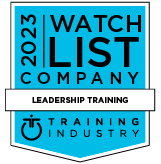Creating Higher Performing Teams with Clarity and Autonomy

Contents
In the dynamic landscape of modern workplaces, effective leadership extends beyond merely setting goals and directives for their teams. It hinges on the delicate balance of providing clear expectations while affording team members the autonomy to achieve those goals. This nuanced approach not only fosters productivity and innovation but also serves as a cornerstone in nurturing psychological safety and higher performance within a team. In this blog, we will explore the vital role that leaders play in creating an environment where team members feel secure, encouraged, and empowered – a place where they can thrive personally and professionally.
The importance of striking the right balance between clear expectations and team autonomy cannot be overstated. Psychological safety within a team is the bedrock upon which a healthy, innovative, and a high performing workplace is built. When leaders provide crystal clear expectations, team members gain a sense of direction and purpose, helping them understand what is required to achieve organizational goals. However, the provision of autonomy, trust, and freedom to approach tasks in their unique ways, is equally vital. It enables team members to harness their creativity, problem-solving skills, and expertise. Resulting in improved engagement and ownership over their work.
In turn, this autonomy empowers individuals to take calculated risks, learn from their mistakes, and adapt to new challenges. As a result, they not only become more confident in their abilities but also more invested in the success of their team and organization. This sense of ownership and empowerment fosters trust, collaboration, and a culture of learning. Failures are seen as opportunities for growth rather than as reasons for blame.

(Illustration and Insight from Roberto Ferraro.)
Clarity in Communication: The Foundation
DX’s definition of Clarity: A shared understanding of crystal clear expectations to achieve collective goals™.

Clear communication is the cornerstone of effective teamwork. When team members communicate with clarity, it eliminates confusion and stress, prevents misunderstandings and duplication of efforts, ensures that everyone is on the same page, and reduces rework. As highlighted in the Harvard Business Review article "The Science of Building a Great Team" (2012), one of the defining characteristics of high-performing teams is their ability to communicate clearly and openly.
Imagine a scenario where team members are uncertain about their roles or the goals of a project. In this environment, employees often find themselves uncertain about what is expected of them and how their work contributes to the organization's overall mission. The resulting ambiguity can lead to anxiety, frustration, and disengagement. As a result, the leaders resort to micro-management, constantly monitoring and directing every aspect of their team's tasks. This lack of goal clarity and excessive micro-management negatively impacts psychological safety within a team. This is why clear communication is so critical. When expectations are set, and information is shared openly, team members can work confidently and proactively. They know what is expected of them and how their efforts contribute to the team's success.
Autonomy and Empowerment: The Catalysts of Engagement
DX’s definition of autonomy: Trusting your team to do what needs to get done on their terms™.
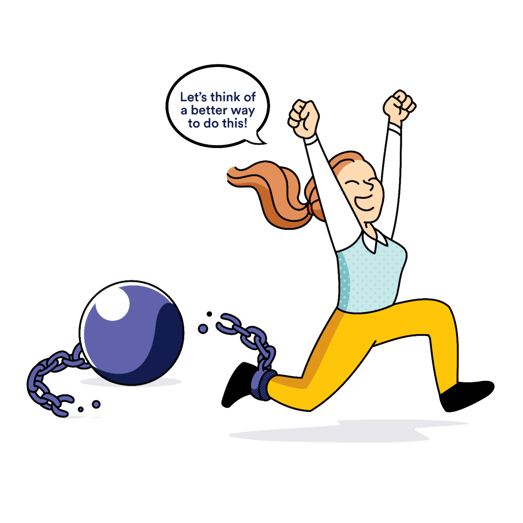
Autonomy and empowerment are potent drivers of employee engagement. Empowering team members with the autonomy to make decisions about their work and providing them with the necessary resources and support can significantly boost their job satisfaction and motivation. This idea is substantiated by Daniel H. Pink's book "Drive: The Surprising Truth About What Motivates Us" (2011), which emphasizes how autonomy is a key intrinsic motivator.
Imagine again a workplace with low autonomy, one where the leaders are in full control. Team members in this organization often feel anxious and stressed due to the constant oversight and lack of autonomy. They become reluctant to take the initiative or voice their opinions because they fear criticism or reprimand for not meeting ambiguous or uncommunicated expectations. This creates a culture of fear and apprehension, hindering open communication and collaboration. Team members become hesitant to share innovative ideas or suggest improvements, as they are uncertain about how these contributions will be received.
As a result, the psychological safety of employees is eroded, and their confidence in their own abilities diminishes. They begin to question their value within the organization, and job satisfaction declines. This, in turn, affects overall productivity and the organization's ability to adapt to change and innovation.
If you take an empowering approach where team members are given the freedom to make decisions about their tasks and the flexibility to choose how to achieve their goals. This environment not only sparks creativity and innovation but also fosters a sense of ownership. Team members feel trusted and valued, which, in turn, bolsters their engagement and commitment to the team's objectives.
The Interaction of Clarity and Autonomy
A team’s performance depends on how well the leader can communicate the desired outcome (Clarity) and how much freedom the team members have to achieve it (Autonomy). Without clarity, the leader has to either micromanage every step or leave the team in confusion and inaction.
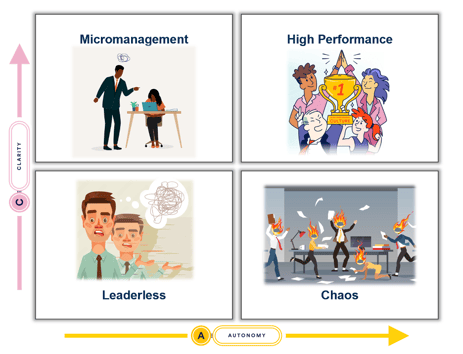
Without autonomy, the team members may lose motivation, creativity, and ownership of their work. They may also miss the mark, leading to wasted time, resources, and morale. The shortest distance between two points is alignment.
Psychological Safety: The Heart of Team Success
Psychological safety, a concept introduced by Amy Edmondson in her article "Psychological Safety and Learning Behavior in Work Teams" (1999), is the glue that holds effective teams together. In an environment of psychological safety, team members feel comfortable taking calculated risks, sharing their ideas, and challenging the status quo.
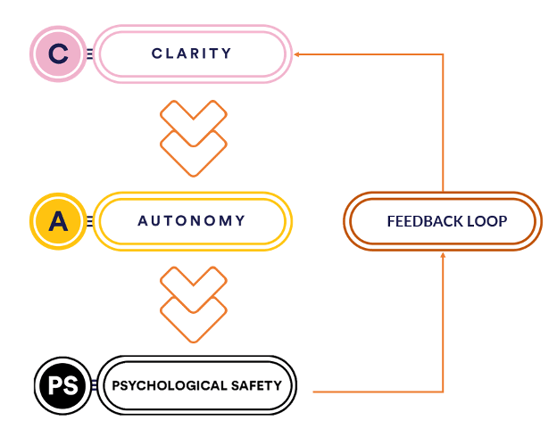
The intricate relationship between clarity of communication and psychological safety becomes evident here. Clear communication establishes the expectations and guidelines that enable team members to interact without fear of judgment. When communication is open and transparent, it builds trust among team members. This trust, as corroborated by a study in the "Journal of Applied Psychology" (2017), is a cornerstone of psychological safety.
Autonomy within a team or organization is a cornerstone of psychological safety. When individuals are empowered to make decisions and take ownership of their work, they experience a sense of control and trust in their abilities. This freedom to act and think independently fosters an environment where team members feel safe to express their ideas, voice concerns, and take calculated risks. They know that they won't face punitive actions or harsh judgment for their contributions, which, in turn, encourages open dialogue and collaboration. Autonomy not only leads to psychological safety but also enhances creativity, innovation, and a sense of belonging within the team, as individuals feel respected and valued for their unique contributions and perspectives.
The Symbiotic Dance
The interaction between clarity of communication, autonomy, and psychological safety is a symbiotic dance. Each element influences and reinforces the others, creating a positive feedback loop that drives team engagement and fosters a culture of continuous improvement.
- Clear Communication Sets the Stage: When communication is clear, it sets the stage for autonomy. Team members know their roles, understand the objectives, and have the information needed to make decisions. Without this, they can’t comfortably be autonomous.
- Autonomy Fosters Psychological Safety: Empowering team members to make decisions encourages open and honest communication. Team members feel safe sharing their ideas and concerns because they are valued contributors.
- Psychological Safety Nurtures Engagement: In an environment where team members are encouraged to speak up, they become more engaged. They are willing to invest their time and effort because they feel that their contributions matter.
- Engagement Enhances Communication: Engaged team members actively participate in discussions, provide feedback, and share their insights. This proactive involvement ensures that communication remains clear and relevant.
- Continuous Improvement: This cycle of clear communication, autonomy, psychological safety, and engagement leads to a culture of continuous improvement. Teams that embrace these principles are more agile, adaptable, and innovative.
Key Takeaways
In today's dynamic work environments, the interplay between clarity of communication, autonomy, and psychological safety is not a mere nicety but a necessity. Clear communication is the foundation upon which autonomy and psychological safety can thrive. Together, these elements create a virtuous cycle that drives team engagement, innovation, and ultimately, organizational success.
By understanding and harnessing the power of these elements, organizations can create workplaces where individuals thrive, collaborate seamlessly, and drive innovation. It's not just about creating teams; it's about fostering a culture where these teams can flourish, succeed, and surpass their own expectations.
DX’s purpose is to bring CARE to the world. Not the cuddly kind. Clarity, autonomy, relationships and Equity® . The 4 leadership habits of higher performance.
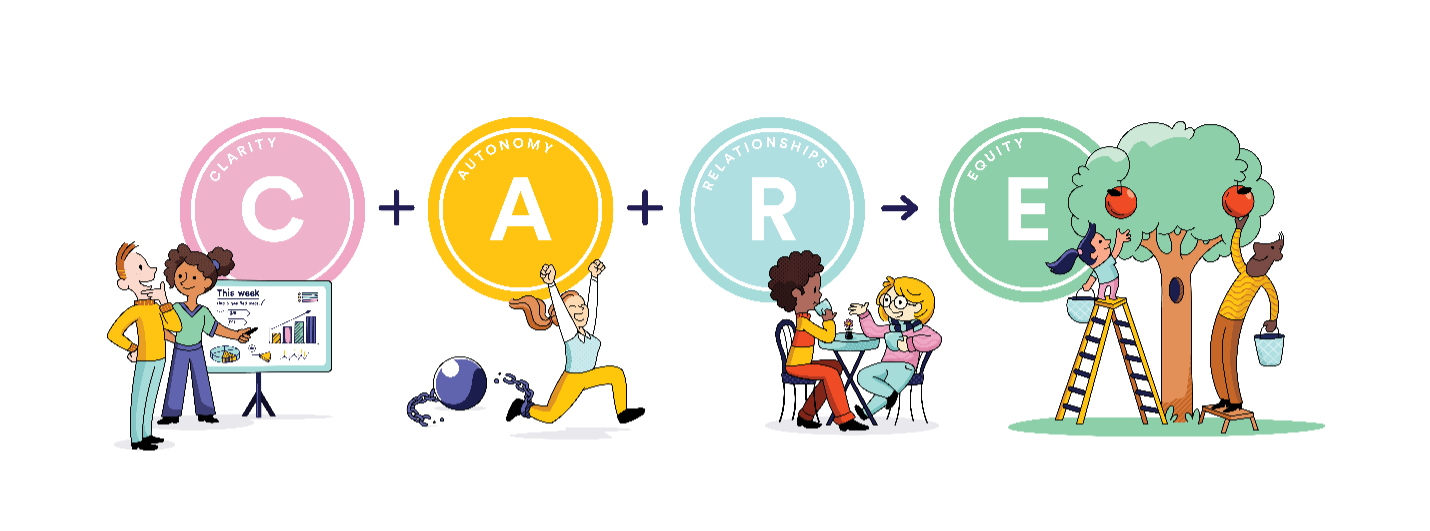
References:
- "The Science of Building a Great Team" (2012) - Harvard Business Review
- "Drive: The Surprising Truth About What Motivates Us" (2011) by Daniel H. Pink
- "Psychological Safety and Learning Behavior in Work Teams" (1999) by Amy Edmondson
- "Journal of Applied Psychology" (2017)
Insights

Subscribe to Our Monthly Newsletter!
For managers and talent professionals who truly believe in putting people first, the CARE to Win blog is your gateway to the latest insights on human-centric leadership. Join us as we champion the people first movement.
Need some time apart? Are we emailing you too often? Just give us your feedback, and we promise we’ll respond. We really do care. And if it’s still too much, just unsubscribe. It’s cool.

